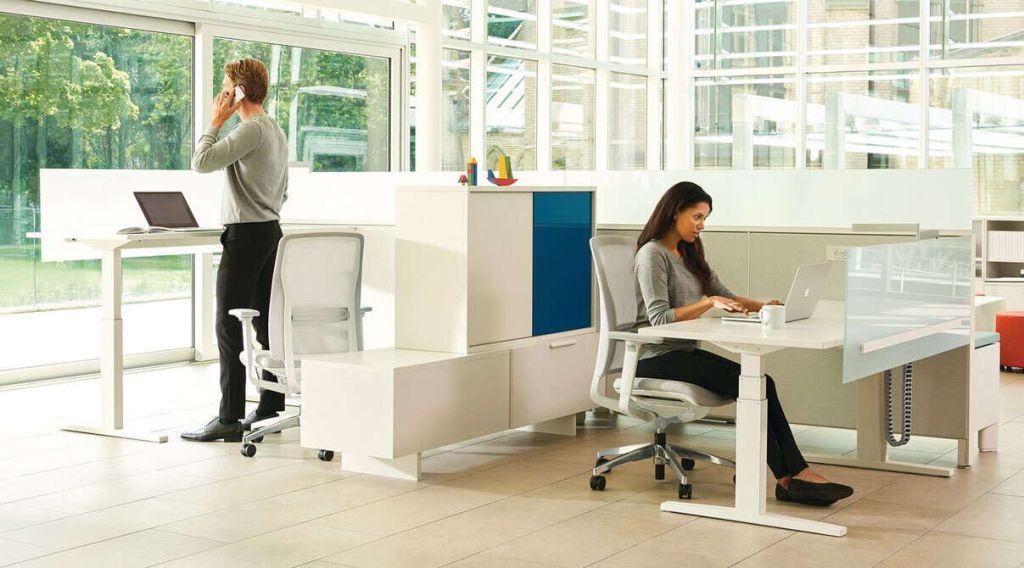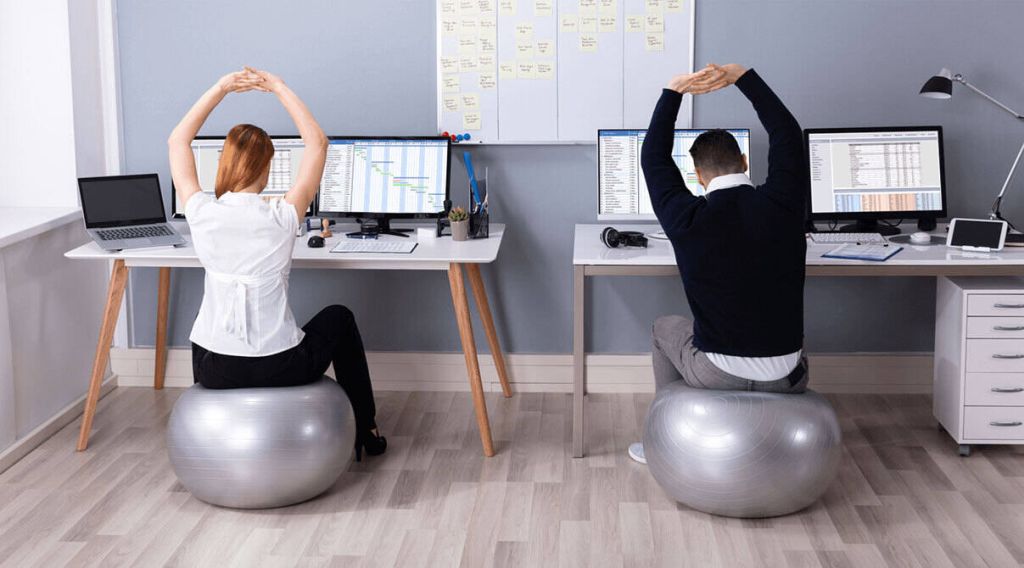People should not suit the workplace; the workplace should suit people. We bring the skill; they provide the equipment; for jobs that require sitting for an excessive amount of time at your desk, ensuring ergonomics is significant. If you’re not comfortable, you will be unable to utilize your brain. Not working ergonomically can be injurious to health as well. Read to find out more.
Ergonomics is the process of creating or organizing workplaces, goods, and systems such that they are comfortable for those who use them.
Most people have heard of ergonomics and believe it is related to sitting or the design of automobile controls and gauges – which it is… But that’s far more than that. Ergonomics is in use for the design of everything that affects people, including workplaces, sports and recreation, and health and safety.
Ergonomics seeks to enhance workplaces and surroundings in order to reduce the risk of damage or harm. As technology evolves, so does the need to ensure that the tools we use for work, relaxation, and pleasure are to meet the needs of our bodies.
You may also be familiar with physical ergonomics. Physical ergonomics is the study of how physical and physiological job demands influence the body and how changes in work demands might avoid accidents. As a result, we consider repeated actions, physical posture, keyboard design, the work environment, and general workplace safety.
Cognitive ergonomics is concerned with human mistakes rather than injuries, such as what shape a knob should have and in which direction it should spin, or how much power a keyboard requires for a response. It’s all about making things more intuitive in order to reduce mistakes.
For example, have you ever walked up to a door with a handle and tried to pull it when you should have pushed it? That is a terrible example of cognitive ergonomics: You were sending out mixed messages. “If you need a sign, it’s not there,” as they say in cognitive ergonomics.
What is the significance of ergonomics?
At the office:
According to Australian and American Research Institutions, lower back pain is the world’s most prevalent work-related ailment, affecting employees in offices, construction sites, and, in the highest risk category, agriculture.
Ergonomics seeks to create safe, pleasant, and productive workplaces by incorporating human talents and limits, such as body size, strength, skill, speed, sensory capacities (vision, hearing), and even attitudes, into the design of a workstation.
In the larger population:
The number of persons around ages 75 and over is expected to be more than double in the next 50 years. As a result, equipment, services, and systems will need to be created to meet the growing demands of the ageing population, including public transportation, building amenities, and living spaces.
Hospitals report a lot of cases of patients with neck, shoulder,and back problems. Most of the time, these patients are 9 to 5 desk employees in one firm or another.
Francisan Health, a hospital in Indiana, says that, “Workplace ergonomics attempts to reduce strain, fatigue and injuries by improving product design and workspace arrangements, such as properly positioning your chair, keyboard and monitor. Having an ergonomically correct workspace can result in less body strain, slouching, twisting and reaching, which can cause musculoskeletal problems and pain over time.”
Most people are in surprise at how fixing a chair and their eye-level can improve a lot of conditions that hamper them from performing daily tasks with ease.
How Does Having Poor Ergonomics Affect Employees?
Poor ergonomics can result in conditions that can have far-reaching impacts on a human being;s body. Prolonged sitting and incorrect posture causes a plethora of problems that include
- A decrease in the levels of good cholesterol
- A spike in blood sugar levels
- Blood pooling in feet and legs
- Slow brain function
- Electrical impulses to the legs are cut off
- Slowed metabolism
- Decreased blood flow and circulation
- Risk of obesity increases because fat fighting enzymes drop
Research has found out that even the individuals who exercise for a few hours every week are unable to fight off the damage of poor workplace ergonomics.
5 Injuries that Proper Ergonomics can Prevent
Poor ergonomics can result in a wide range of issues that require medical attention. In some cases, the damage caused runs so deep that the pain can only be managed and can’t be permanently treated. Proper ergonomic measures can help prevent these conditions from exacerbating. This includes sitting in a well-lit room with proper posture on a comfortable chair, taking regular breaks, and doing exercises.
Poor Ergonomics can Result in Musculoskeletal Disorders (MSDs)
MSDs are painful sources of illnesses. These disorders affect tendons, nerves and muscles. The most common disease among these disorders is the CTS (known as Carpal Tunnel Syndrome). This condition affects the nerve leading to the wrist causing unpleasant pains, numbness and tingling. One more MSD which is very common is Tendonitis. This condition irritates and infames the tendons. It can be caused due to improper posture or position. This condition can affect the kneecap, wrist and elbow. Also severe cases of MSDs may result in paralysis.
Poor Ergonomics can Result in Back Injuries
Employees who work at desk jobs are at the highest risk of back injuries. In addition to that, people who have to work long hours standing, such as nurses, also suffer from back problems. Individuals who have to lift heavy objects such as construction workers and those who work in the food industry lifting heavy trays are also vulnerable to back injuries. Lifting items from below the knees and above the shoulders can twist the back and result in paralysis. Learning the correct way of lifting objects, and taking a five minute stretching break every 40 minutes can help in reducing back injuries.
Poor Ergonomics can Result in Headaches & Migraines
Working long hours in poor lighting may result in headaches and migraines that were not present before. Eyes and brain work differently in various lighting situations. If the light is too dim or bright in the room you work in, or your computer has extreme settings for brightness, chances are you will develop headaches and migraines. This can also lead to nausea, blurred vision, indigestion, burning, itching and fatigue in eyes. In order to avoid these troubling conditions, get yourself eye lubricants. Also, practice various eye exercises every 40 minutes, and switch your computers and rooms to optimum brightness.
Poor Ergonomics can Result in a Stiff Neck
Severe pain and immobility in the neck are often attributed to bad sleeping postures. However, this couldn’t be far from the truth. To everyone’s surprise, more often than not, they are caused by poor ergonomics in the workplace. If you keep your neck too rigid and in the same place for a long time, you are going to suffer a stiff neck. Also, if you have bad posture and you bend over too much on your laptop while working, it can result in cervical pain, which is debilitating and requires long term treatment.
Poor Ergonomics can Result in “Trigger Finger”
“Trigger fingers” is the inflammation of tendon sheaths in the fingers. This can be related to the RSI or repetitive strain injuries. Individuals who write a lot, who are surgeons, and who do embroideries and stitching experience this the most. It can also be caused by gripping things too tightly or for too long. This results in having difficulty moving fingers without experiencing a sharp, stabbing pain. This can be avoided by taking adequate breaks between your working hours and doing exercises to keep your finger health intact.
How to make Work Place more Ergonomic?
Make the Computers Work
Ensure that the employees are working with ergonomically-approved computers and laptops. The keyboard and the mouse must be on the same level, and the arms should be on the armrest. The wrists must remain straight while typing anything. If there is a need to look at documents while typing on the computer, a document holder should be provided.other tools such as sharpeners and pencils must be well within reach. If your employees need to use phone continuously, provide them with a handsfree.
Take account of Varying Heights
Case study: Three employees work in a marketing firm, they all perform the same job, using the same equipment (chair, desk, and a laptop). They may be of vastly different heights, which would make it impossible for the same chair to desk distance and height work for everyone. Of the three, some might be stooping, others stretching to accomplish the same task. This will result in ergonomic injuries such as neck and back strain. Providing them with height adjustable equipment such as movable desks and adjustable chairs will help solve the problem.
Add more to the Standard Assessment in the Workplace
Dr. Rafi Terzian writes in Industry Week that, “Ensure that any workplace assessment not only takes into account the unique factors of the facility’s environment, but also the hazards specific to each employee’s role. While some employees may be standing on their feet all day, others may be lifting heavy objects or working in awkward positions. It is critical to involve employees in this process to address the issues affecting each individual’s health and productivity.”
Assessments should be tailored to individual employees to ensure a safe working environment.
Select appropriate safety equipment
The assessment results should be used in providing safety equipment to the employees who need it the most. These equipment should encourage safe postures, protect from the MSDs and help in heavy lifting of objects. The safety gear may include:
- Floor mats with cushioning for the individuals who need to stand for extended periods of time.
- For those who have deskjobs, chairs with ergonomic design should be given, which can be adjusted for customized requirements.
- Human labor shouldnt be required in moving heavy items, carts and other machinery should be installed for this purpose.
- For individuals who have to work with their knees, knee pads should be provided to reduce pressure.
Consistently Communicate and Educate
Workplaces should conduct seminars and classes to educate their employees on the ways to avoid ergonomic injuries. They must remember to take breaks, adjust the repetitive movements, avoid hazards, and employ the use of protective gear everyday. In addition to the initial orientational ,the employees need training on ergonomics periodically to keep the lesson fresh in mind. This is because when a task is of repetitive nature, frequent outreach helps in keeping the message relevant.
The Role of HR in Addressing the Work Place Ergonomics
Human resources can play a vital role in addressing issues pertaining to workplace ergonomics. Their important tasks in this aspect include:
- Coordinating seminars and training camps that educates the employees about ergonomics so that the risk of MSDs is less.
- Running ergonomic assessment of each employee by the company’s health unit or any third party.
- Establishing policies that support and encourage employees with MSDs. The HR must formulate ways for their appropriate return to work.
- Networking with the worker’s compensation, medical insurance, and medical benefits careers
- Guiding the employees in getting the necessary resources in understanding, preventing and treating the existing MSDs
The Future of Work Spaces
The future of work spaces looks good ergonomically. When the employees are educated and communicated with the benefits of ergonomics, there will be fewer and fewer incidents of MSDs. Future of Business and Tech notes that,
“Ergonomics is critical to wellness because it directly affects the risks of musculoskeletal disorders that currently cost U.S. businesses $1 billion per week. Ergonomists know how to improve the design of office workplaces so that people will work in neutral postures that will benefit their health, eliminate musculoskeletal injury risks and boost their productivity.”
This cost will go close to zero when workplace ergonomics is in practice religiously.
For the employers in terms of both direct and indirect costs per annum. Following and developing a comprehensive plan to combat the MSDs and reducing the chances of ergonomic injuries will benefit both the employers and the employees alike.
How to Get the Advantages of Ergonomics?
The only way to reap the benefits of ergonomics is to begin making adjustments. You can begin with individual workstations and gradually reduce dangers. Talk to your staff to acquire their perspectives, which you can then blend with your own.
Before making modifications, consider your situation, the layout, and your needs. You will obtain the greatest possible workplace with appropriate preparation. Also you should learn more about assisting with the creation of ergonomic workstations for your company.
Other Suggestions:
There are more techniques to make working more comfortable. Small changes, according to the National Institutes of Health, can lead to greater comfort and productivity. They recommend the following for adults:
- Exercises for the eyes
- Exercises for the back
- First, warm up.
- Rest is essential.
You may share these ideas with your coworkers by putting them somewhere visible or by sending email reminders. These suggestions, when paired with an ergonomic office, can help your business. Everyone will have a more comfortable workday if you implement the suggestions above.
Today, take advantage of a better working environment.
You’re one step closer to creating a better working environment for yourself and your coworkers. Now that you’re aware of these nine outstanding workplace ergonomics benefits, it’s time to make a change. Remember to share the knowledge you gained today with your staff.
With the correct materials and expertise, you can grow your business. Also we provide you the information you need to succeed. Explore our website for a bit longer to get the greatest tips and techniques.